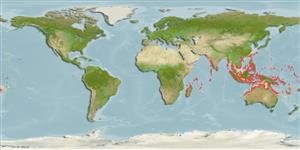Common names from other countries
Environment: milieu / climate zone / depth range / distribution range
Écologie
Récifal; profondeur 3 - 35 m (Ref. 8294). Tropical; 28°N - 30°S, 41°E - 169°W (Ref. 846)
Distribution
Pays | Zones FAO | Écosystèmes | Occurrences | Introductions
Indo-Pacific.
Length at first maturity / Taille / Poids / Âge
Maturity: Lm ? range ? - ? cm
Description synthétique
Morphologie
Corymbose clumps colonies. Thin and spreading horizontal branches. Fine upward projecting branches. Naniform radial corallites on branch sides with slightly flaring lips. Usual color: Grey or bright blue-green or yellow. Branch tips: Yellow, lime, green, pale blue or brown.
Maximum depth from Ref. 98471. Inhabits upper reef slopes, lagoons (Ref. 846) and walls (Ref. 98471).
Life cycle and mating behavior
Maturité | Reproduction | Frai | Œufs | Fécondité | Larves
Hermaphroditic (Ref. 113712). Mature gametes are shed into the coelenteron and spawned through the mouth. Life cycle: The zygote develops into a planktonic planula larva. Metamorphosis begins with early morphogenesis of tentacles, septa and pharynx before larval settlement on the aboral end (Ref. 833).
Veron, J.E.N. 2000. (Ref. 846)
Statut dans la liste rouge de l'IUCN (Ref. 130435)
statut CITES (Ref. 108899)
Not Evaluated
Utilisations par l'homme
| FishSource |
Outils
Sources Internet
Estimates based on models
Preferred temperature
(Ref.
115969): 24.8 - 29, mean 28.1 (based on 740 cells).
Catégorie de prix
Unknown.
